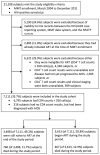Predictors of accessing antiretroviral therapy among HIV-positive drug users in China's National Methadone Maintenance Treatment Programme
- PMID: 25533863
- PMCID: PMC5596174
- DOI: 10.1111/add.12782
Predictors of accessing antiretroviral therapy among HIV-positive drug users in China's National Methadone Maintenance Treatment Programme
Abstract
Aims: The objective of this study was to examine factors that predict antiretroviral therapy (ART) access among eligible, HIV-positive methadone maintenance treatment (MMT) clients. We also tested the hypothesis that sustained MMT participation increases the likelihood of accessing ART.
Design: A nation-wide cohort study conducted from 1 March 2004 to 31 December 2011.
Setting: MMT clients were followed from the time of their enrolment in China's national MMT programme until their death or the study end date.
Participants: Our cohort comprised 7111 ART-eligible, HIV-positive MMT clients, 49.2% of whom remained ART-naive and 50.8% of whom received ART.
Measurements: Demographic variables, drug use history, MMT programme participation and HIV-related clinical characteristics of study participants who remained naive to ART and those who accessed ART were compared by univariate and multivariable analysis.
Findings: Predictors of accessing ART among this cohort included being retained in MMT at the time of first meeting ART eligibility [adjusted odds ratio (AOR)=1.84, confidence interval (CI)=1.54-2.21, P<0.001] compared to meeting ART eligibility before entering MMT (AOR=0.98, CI=0.80-1.21, P=0.849) or previously entering MMT and dropping out before meeting ART eligibility. Additional predictors were CD4≤200 cells/μl when ART-eligibility requirement was first met (AOR=1.81, CI=1.61-2.05, P<0.001 compared to CD4=201-350 cells/μl), and being in a stable partner relationship (married/cohabitating: AOR=1.14, CI=1.01-1.28, P=0.030).
Conclusions: Retained participation in methadone maintenance treatment increases the likelihood that eligible clients will access antiretroviral therapy. These results highlight the potential benefit of colocalization of methadone maintenance treatment and antiretroviral therapy services in a 'one-stop-shop' model.
Keywords: Antiretroviral therapy; China; HIV/AIDS; drug user; heroin; methadone maintenance treatment.
© 2014 Society for the Study of Addiction.
Figures



Similar articles
-
Dose-response relationship between methadone dose and adherence to antiretroviral therapy among HIV-positive people who use illicit opioids.Addiction. 2015 Aug;110(8):1330-9. doi: 10.1111/add.12970. Addiction. 2015. PMID: 25940906 Free PMC article.
-
Who uses methadone services in China? Monitoring the world's largest methadone programme.Addiction. 2015 Jan;110 Suppl 1:29-39. doi: 10.1111/add.12781. Addiction. 2015. PMID: 25533862
-
Mortality among methadone maintenance clients in China: a six-year cohort study.PLoS One. 2013 Dec 12;8(12):e82476. doi: 10.1371/journal.pone.0082476. eCollection 2013. PLoS One. 2013. PMID: 24349294 Free PMC article.
-
The role of the Chinese police in methadone maintenance therapy: a literature review.Int J Drug Policy. 2013 Nov;24(6):e25-34. doi: 10.1016/j.drugpo.2013.03.010. Epub 2013 Apr 25. Int J Drug Policy. 2013. PMID: 23623719 Review.
-
Retention in methadone maintenance treatment in mainland China, 2004-2012: a literature review.Addict Behav. 2014 Jan;39(1):22-9. doi: 10.1016/j.addbeh.2013.09.001. Epub 2013 Sep 9. Addict Behav. 2014. PMID: 24090627 Review.
Cited by
-
The Decade-Long Chinese Methadone Maintenance Therapy Yields Large Population and Economic Benefits for Drug Users in Reducing Harm, HIV and HCV Disease Burden.Front Public Health. 2019 Nov 12;7:327. doi: 10.3389/fpubh.2019.00327. eCollection 2019. Front Public Health. 2019. PMID: 31781529 Free PMC article.
-
Strategies to control HIV and HCV in methadone maintenance treatment in Guangdong Province, China: a system dynamic modeling study.Subst Abuse Treat Prev Policy. 2018 Jan 10;13(1):1. doi: 10.1186/s13011-017-0140-3. Subst Abuse Treat Prev Policy. 2018. PMID: 29321039 Free PMC article.
-
Trends and risk factors for HIV, HCV and syphilis seroconversion among drug users in a methadone maintenance treatment programme in China: a 7-year retrospective cohort study.BMJ Open. 2015 Aug 21;5(8):e008162. doi: 10.1136/bmjopen-2015-008162. BMJ Open. 2015. PMID: 26297365 Free PMC article.
-
ART uptake and adherence among women who use drugs globally: A scoping review.Drug Alcohol Depend. 2020 Oct 1;215:108218. doi: 10.1016/j.drugalcdep.2020.108218. Epub 2020 Aug 2. Drug Alcohol Depend. 2020. PMID: 32916450 Free PMC article.
-
HIV treatment cascade among people who inject drugs in Ukraine.PLoS One. 2020 Dec 31;15(12):e0244572. doi: 10.1371/journal.pone.0244572. eCollection 2020. PLoS One. 2020. PMID: 33382768 Free PMC article.
References
-
- Joint United Nations Programme on HIV/AIDS. UNAIDS Report on the Global AIDS Epidemic 2010. Geneva: Joint United Nations Programme on HIV/AIDS; 2010.
-
- Mathers B, Degenhardt L, Phillips B, Wiessing L, Hickman M, Strathdee S, et al. Global epidemiology of injecting drug use and HIV among people who inject drugs: a systematic review. Lancet. 2008;372(9651):1733–45. - PubMed
-
- National Narcotics Control Commission. Annual Report on Drug Control in China 2011. Beijing: Ministry of Public Security; 2011.
-
- Ministry of Health, Joint United Nations Programme on HIV/AIDS, World Health Organization. 2011 Estimates for the HIV/AIDS Epidemic in China. Geneva: World Health Organization; 2011.
-
- Mathers B, Degenhardt L, Ali H, Wiessing L, Hickman M, Mattick R, et al. HIV prevention, treatment, and care services for people who inject drugs: a systematic review of global, regional, and national coverage. Lancet. 2010;375(9719):1014–28. - PubMed
Publication types
MeSH terms
Substances
Grants and funding
LinkOut - more resources
Full Text Sources
Other Literature Sources
Medical
Research Materials
Miscellaneous

